These historic photos reveal how rail travel used to look
Rail travel through the ages

Tim Graham Picture Library/Getty Images
Rail travel has long captured the imagination of people, from the first transcontinental journeys in North America and Australia to groundbreaking British trains and incredible advancements by the Japanese. Join us as we travel back in time to take a look at how rail travel became the transport stalwart it is today, marvel at the glamour of railroad cars of the past and celebrate notable moments in railway history.
1860s: British royals embrace train travel

RDImages/Epics/Getty Images
Built by Wolverton Works in 1869, this is the furnished interior of Queen Victoria's saloon carriage. In 1842, she was the first British monarch to travel by train when she took a Great Western Railway train from Slough to Paddington. Twenty-seven years later, Queen Victoria commissioned two railway coaches, a sleeping car and a saloon car, and the latter was reputedly the queen's favourite railway vehicle. It's now on show at the National Railway Museum in York.
1870s: an early railroad bridge in Arizona

CORBIS/Corbis via Getty Images
One of the biggest obstacles railroads faced in the early days was traversing the often challenging landscapes. One such place was Canyon Diablo in Arizona – this is the earliest inception of a railroad bridge across the canyon photographed at some point in the 1870s. The current steel bridge was finished in 1903, but the foundations of the original trestle bridge can still be seen today.
1880s: luxurious interior of a railroad car

Bettmann via Getty Images
Before the turn of the 20th century, rail travel was expensive, especially in America, but Chicago-based Pullman Company, led by George Pullman found a way to make it even more luxurious. Founded in 1867, the company produced a range of ornate dining, sleeping and parlour cars and even private cars for the super wealthy. These cars would be attached to commercial passenger trains and were essentially mini mansions on wheels.
1880s: first transcontinental train in Canada

The Print Collector/Print Collector/Getty Images
Built between 1881 and 1885, the Canadian Pacific Railway's first line connected eastern Canada with British Columbia. The first train to travel the full route departed Montreal's Dalhousie Station at 8pm on 28 June 1886 and reached the final terminus on the western seaboard, Port Moody, at noon on 4 July. Here, that first train is photographed in Fernie, some 600 miles (900km) east from Port Moody.
1890s: dining car on the Chicago Great Western Limited

Library of Congress/Public Domain via Picryl
Chicago Great Western Railway was a relatively small railroad chain, its routes mostly connecting Chicago and the Twin Cities. What it lacked in size though, it made up for in elegance and glamour. The daily Great Western Limited trains connecting Chicago and Kansas City didn't skimp on lavishness either, as seen in this photograph of the dining car, captured in 1899. Dedicated dining cars were already a normal part of long-distance trains by the mid-1880s.
1890s: barber shop on board a train

Museum of the City of New York/Byron Co. Collection/Getty Images
As the wealthiest passengers' wants and needs grew larger, trains became even more luxurious, turning into 5-star hotels, restaurants and salons on wheels. This barber operated a shop aboard a train of the Erie Railroad, connecting New York City and Jersey City with Cleveland, Buffalo and Chicago.
1900s: all about comfort
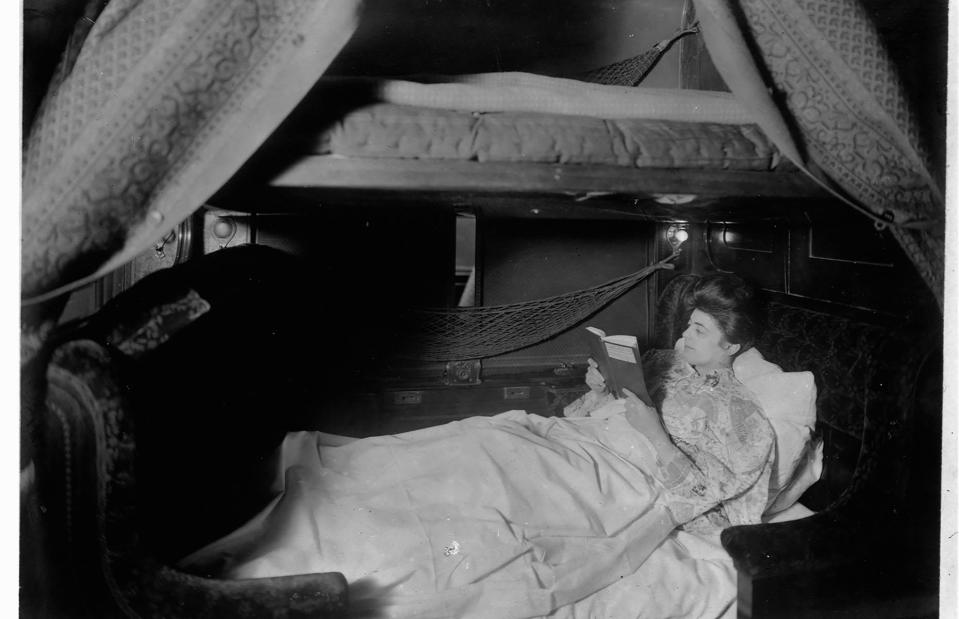
Library of Congress/Corbis/VCG via Getty Images
While train travel was still considered a luxury, especially for the wealthier passengers, rather than just a mode of transport, comfort was a priority. Photographed in 1905, this woman is enjoying reading a book before bed in her spacious bunk on a sleeping car.
1910s: British royals on tour

Hulton Archive/Getty Images
For many years trains were and on some occasions still are the top choice for travel across the UK for the British royals. Here, King George V and the royal party are captured leaving Glasgow Station during a royal tour of Scotland in 1914.
1910s: train travel for everyone

Topical Press Agency/Getty Images
As trains grew more and more popular around the world, plenty of people were keen to enjoy this speedier way of travel. Obviously, third class comfort was nowhere near the service first class passengers enjoyed. Yet these children and young adults are still excited for their holiday trip to Bognor Regis on the south coast of England, photographed before leaving London Bridge station in July 1913.
1910s: Darjeeling Himalayan Railway loop

The Print Collector/Print Collector/Getty Images
A UNESCO World Heritage Site, the Darjeeling Himalayan Railway is undoubtedly one of the world's most famous trains. Built between 1879 and 1881, the line is about 55 miles (89km) long and uses six zig-zags and five loops to gain an altitude of just under 7,000 feet (2,134m). One such loop is loop No.4 or Agony Point loop, photographed here in around 1910.
1920s: first non-stop service of the Flying Scotsman
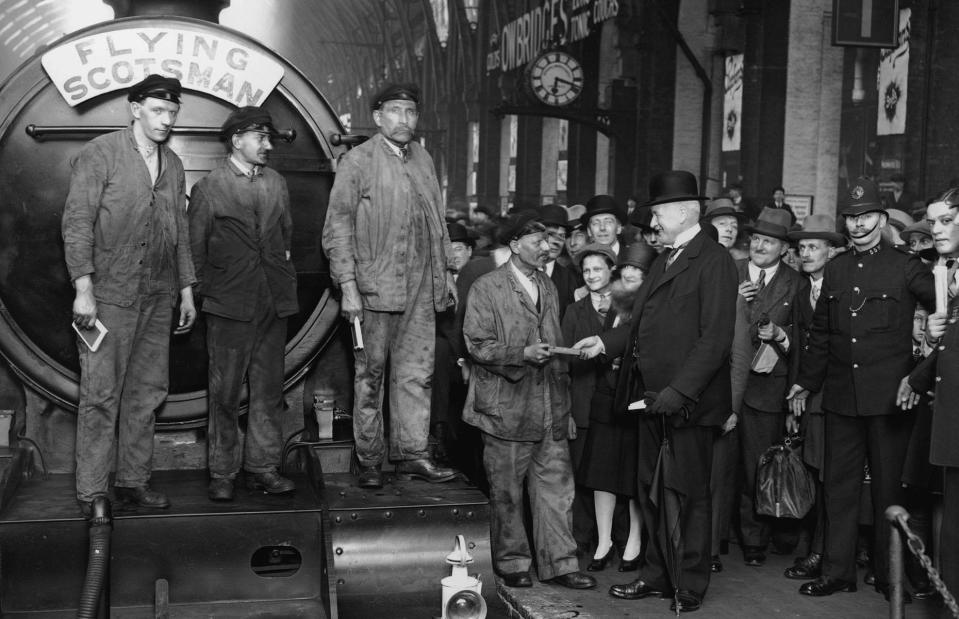
Edward G. Malindine/Topical Press Agency/Hulton Archive/Getty Images
One of Britain's most famous trains, the Flying Scotsman, embarked on its first journey in 1862, however, it wasn't until May 1928 that it completed its first non-stop service between Edinburgh and London. In this image captured at King's Cross Station in London, the train driver and firemen are presented with souvenirs to mark the occasion. This particular locomotive (LNER Class A3 4472) also set two steam locomotive world records, first reaching a speed of 100mph (161km/h) and then for the longest non-stop run of 442 miles (711km) while in Australia in 1989.
1920s: Swedish State Railways Second Class

Digital Museum/Public Domain via Picryl
This image shows that travelling in second class was still very comfortable in some state-operated trains like Sweden. The SJ on the embroidered head rest covers stands for Statens Järnvägar – Swedish for Swedish State Railways.
1920s: new entertainment on board

Bettmann via Getty Images
Trains also started providing new forms of entertainment on board to help passengers pass the time in comfort. Gone were the days of looking through the window for hours on end as radio was introduced to entertain travellers aboard the Northwest Railroad running out of Milwaukee. Radios were installed on every car and passengers could pass the time listening to music or stories broadcasted over the radio waves.
1930s: films on trains
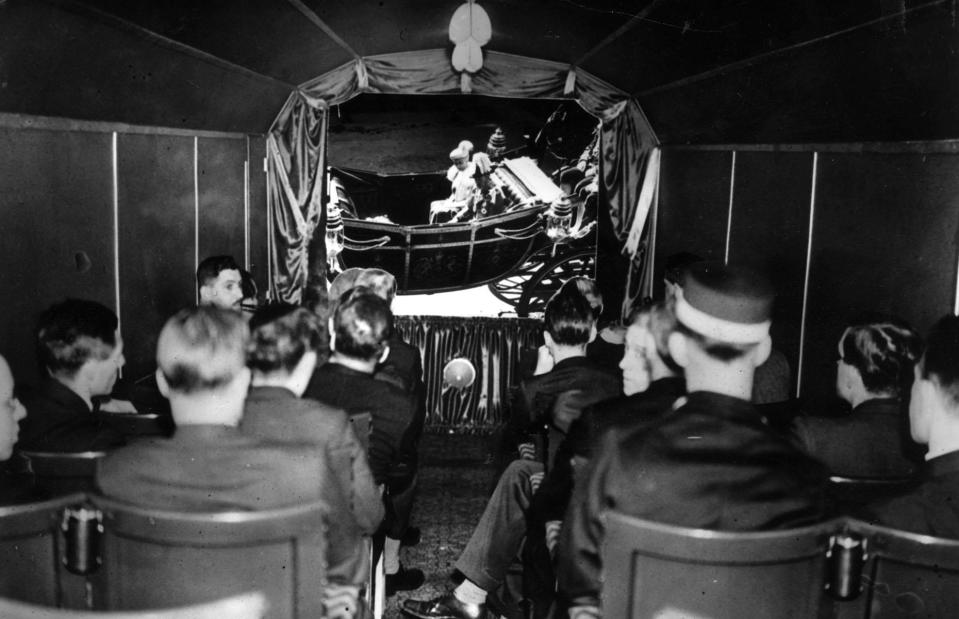
David Savill/Topical Press Agency/Getty Images
The UK took a similar approach in 1935 when King George V's Silver Jubilee film was shown on board the train departing London King's Cross to Peterborough.
1920s: holiday rush

Hulton-Deutsch Collection/CORBIS/Corbis via Getty Images
As summer arrived, Paddington Station in London in June 1926 looked no different to how Stansted Airport does today before holiday season. Crowds are pictured waiting to board trains for Cornwall – an especially sought-after holiday destination for Londoners at the time.
1930s: sleeping in comfort

Culture Club/Getty Images
Although the 1930s was a turbulent decade largely defined by the stock market crash and the Great Depression in the US, as well as the start of the Second World War, the Roaring Twenties had left its mark on train travel. Still a rather luxurious experience, especially for the wealthy, here two ladies in silk nightwear are captured inside a sleeping compartment on a Union Pacific Railroad train in the 1930s.
1930s: battling baggage

John F. Stephenson/Topical Press Agency/Getty Images
Whether it's train travel in the 1930s or jetting away on an aeroplane in the 2000s, there's still baggage to be loaded and unloaded. Here baggage men unload passengers' suitcases from a train that's arrived at London Waterloo station.
Take a look at how air travel has changed in the last 100 years
1930s: summer holidays in the Austrian countryside

The Print Collector via Getty Images
When tourism skyrocketed in the second half of the 19th century and areas around Vienna became popular with travellers from all across Europe, the mountainous Schneeberg region emerged as a favourite summer resort for the wealthy. Here are a group of hikers disembark the Schneeberg Railway at Baumgartnerhaus Station in 1935.
1940s: long-haul journeys in comfort

Archive Photos/Getty Images
Introduced in November 1939, Rocky Mountain Rocket was one of the six streamlined trains travelling between Chicago and Denver. As competition along that route was stiff, the Rocket offered its passengers total comfort during the 13-hour trip. The train had a 32-patron diner and 14-patron cocktail lounge cars, two sleeping cars and a sleeper-observation car as well as coaches with wide and cushioned reclining seats.
1940s: new luxury trains

Bettmann via Getty Images
Post-war America was very keen to quickly move past the tragedies of the war and usher in a new capitalist and consumerist era, and rail travel certainly benefited from this new attitude. Launched in 1948, this was the new observation car of the 20th Century Limited, a New York Central Railroad train running between New York City and Chicago. The new luxuriously appointed trains were (and still are) among the world's greatest trains and the phrase 'red carpet treatment' comes from the specially designed crimson carpets on this train.
1950s: lounge on the Southern Pacific Sunset Limited
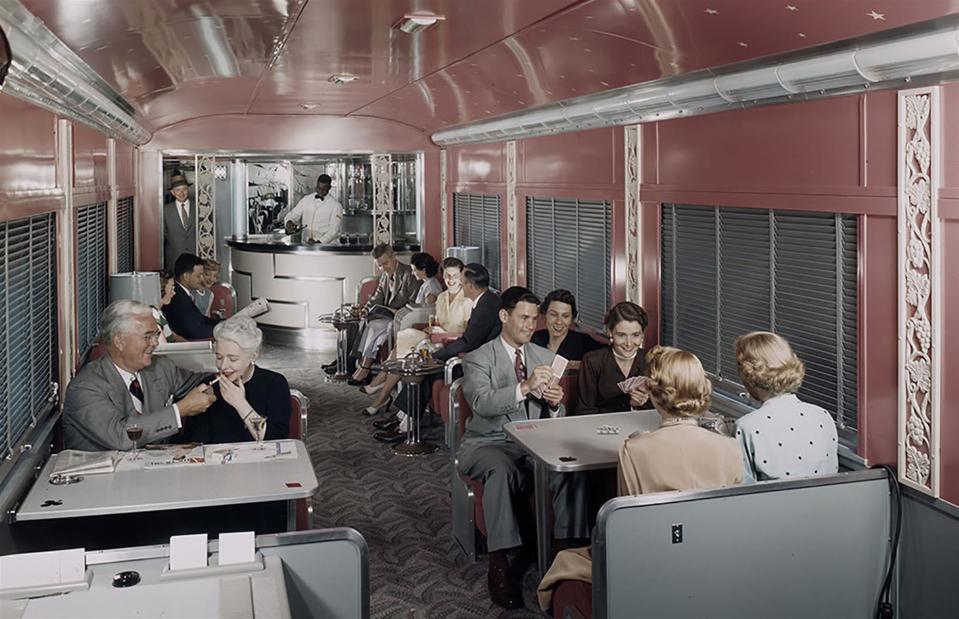
Southern Methodist University's Central University Libraries/Public Domain via Picryl
Operated by the Southern Pacific Railroad, Sunset Limited was a route connecting New Orleans with Los Angeles. The oldest named train in the US, Sunset Limited started operations in 1894 and, having opened 20 years before the Panama Canal, offered a quicker connection between the East and West Coasts. Here, travellers are seen passing the time in one of the two lounge cars in the 1950s.
1960s: a dream of Eurotunnel

-/AFP via Getty Images
Although construction on the Channel Tunnel, known as Eurotunnel, didn't begin until 1988, plans to build such a tunnel emerged as early as 1802. Here, British Transport Minister Barbara Castle is photographed with the French SNCF (France's national state-owned railway company) CEO André Segalat on 29 October 1966. They're standing onboard a train-car, showcasing how the transport through the tunnel would work, some 30 years before it actually happened.
1960s: high-speed rail travel is unveiled in Japan

Dean Conger/Corbis via Getty Images
A huge advancement in modern day rail travel, Japan's new high-speed Shinkansen trains shortened the travel time between Tokyo and Osaka by three hours and 10 minutes. Launched in 1964, just in time for the first Tokyo Olympics, the new bullet trains quickly grew in both popularity and size. Here, a bullet train travels on the first Shinkansen Tokaido Line with Mount Fuji in the background in 1968.
1970s: the dome car of the Southwest Limited

U.S. National Archives and Records Administration/Public Domain via Wikimedia Commons
An Amtrak train between Los Angeles, California and Chicago, Illinois, the Southwest Limited passed through the enchanting landscapes of New Mexico and Arizona. The new dome cars were perfect for sightseeing and were introduced as early as the 1950s by the Budd Company. Here, passengers enjoy the surrounding views in 1974 on the Southwest Limited, now Southwest Chief.
Here are stunning historic images of theme parks in full swing
1970s: the inaugural journey of the Indian Pacific

William Lovelace/Express/Getty Images
Surprisingly, it wasn't until 23 February 1970 when Australia's two coasts were finally linked by a direct rail service. More than 2,700 miles (4,345km) long, the journey between Perth in Western Australia and Sydney in New South Wales took around 75 hours to complete. Here, the new Indian Pacific (originally named The Transcontinental) is making its first journey in 1970.
1970s: final journey of the Orient Express
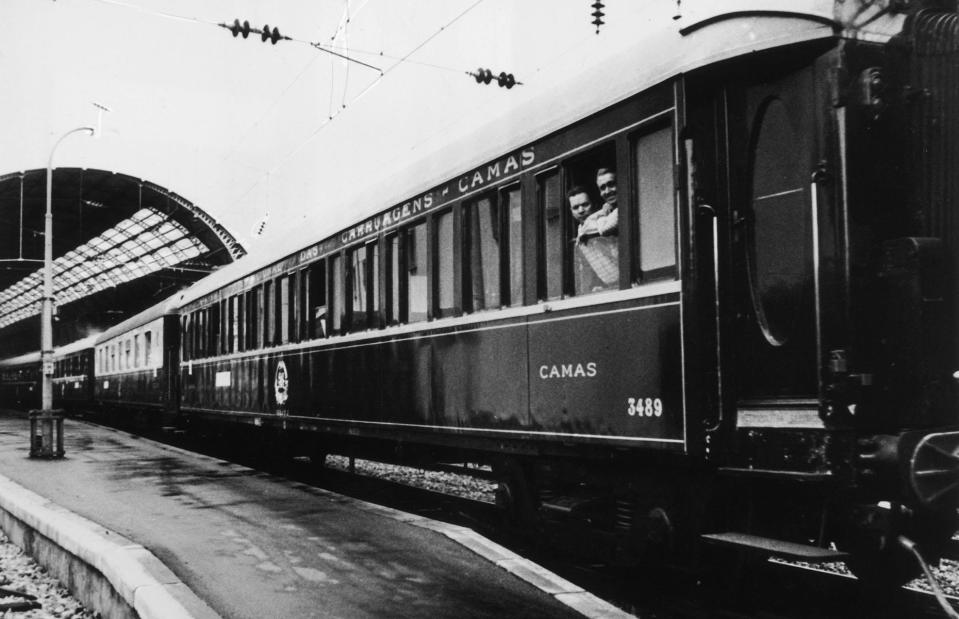
Keystone/Hulton Archive/Getty Images
A bittersweet moment is captured here in October 1977 as the Orient Express, the glamorous long-distance passenger service, stops in Monte Carlo along its final direct journey from Paris to Istanbul.
1980s: business on the go

Bettmann via Getty Images
Not at all a surprising sight on any train today, this gentleman from the 1980s is well ahead of his time as he's using precious commute time to do work on an early Hewlett-Packard laptop.
Discover vintage photos of American summer vacations
1990s: ladies en route to the Royal Ascot, England
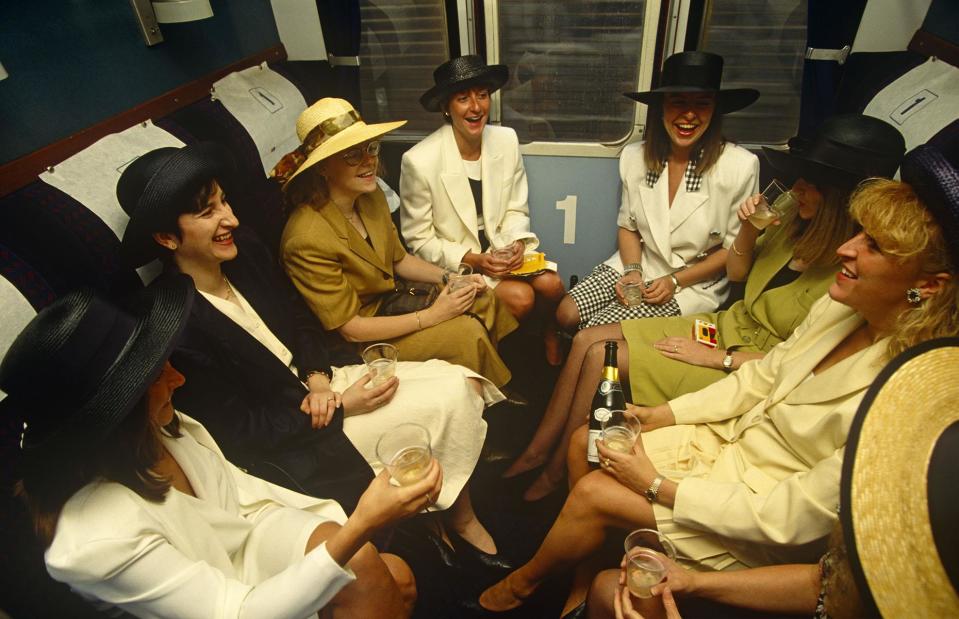
In Pictures Ltd./Corbis via Getty Images
Throughout the ages trains have played a significant part in people's lives. While private car ownership has steadily risen since the 1980s, trains are still often a significant part of special occasions like this one. Here, captured in 1993, a group of women are travelling from London Waterloo to Royal Ascot in Berkshire for Ladies Day during the Royal Ascot racing week.
1990s: Queen Elizabeth II and Prince Philip aboard Eurostar

Tim Graham Picture Library/Getty Images
The dream of a tunnel and a train connecting mainland Europe and the UK finally came true in 1994 when both the Eurotunnel and Eurostar were launched. Here, Queen Elizabeth II and Prince Philip are joined by Prime Minister John Major (sitting behind the Queen) aboard a Eurostar train on the inauguration of the tunnel on 6 May 1994.
2000s: Amtrak employees in front of the new Acela Express train

Library of Congress/Public Domain
Train travel in America reached new highs with the launch of Amtrak in May 1971, but its flagship service Acela Express, launched in 2000, is by far the most successful route. Connecting Washington DC and Boston via 16 stops that include Baltimore, Philadelphia and New York City, it's an essential service not only for travellers, but commuters too. They are also the fastest trains in the Americas, achieving speeds up to 150mph (241km/h). Here, proud Amtrak employees show off their new uniforms in front of the newly launched train.
2000s: aboard the American Orient Express

David McNew/Newsmakers
A new incarnation of the famous train, the American Orient Express, formerly the American European Express, operated between 1989 and 2008. A private luxury train operating under Amtrak, it offered its passengers an all-inclusive journey with meals, entertainment and hotel stays along the route. The 1940s and 1950s-era passenger cars cost nearly £12 million ($15m) to restore and tickets were priced up to £7,973 ($10,000) per person one way.
Now take a look at the world's most scenic train journeys that don't cost a fortune


